What Your Blood Type Says About You, In 6 Charts
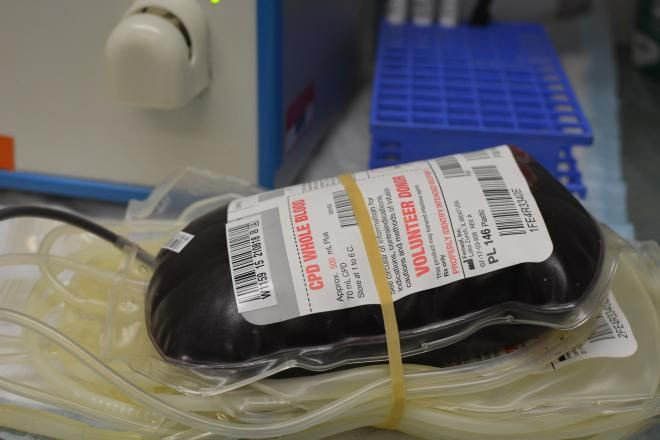
This question originally appeared on Quora. Answer by Tirumalai Kamala.
People with the same blood group have similar risk for various diseases, specifically certain cancers, cardiovascular disease, and increased susceptibility and more adverse outcome to some infectious/communicable diseases.
Blood group is typically defined by presence or absence of certain antigens on the surface of RBCs (Red blood cell ). Of the ~35 different current blood group systems, the ABO blood group system, the focus of this answer, is considered the most important (see below from 1, 2, 3), especially for transfusion medicine.
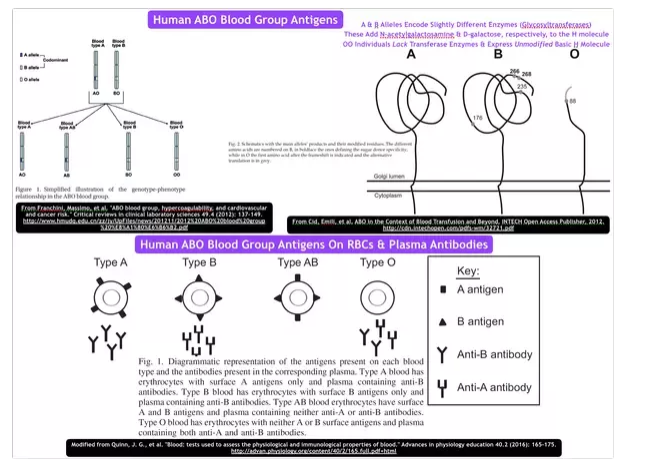
Ironies About The Human ABO Blood Group System
- Though Karl Landsteiner discovered them all the way back in 1900, hardly anything is known about their function.
- However, function they must have not only because that's nature's way but also because they are widely expressed, in endodermal origin tissues of more ancient species such as amphibians and reptiles while also being expressed in ecto- and mesodermal tissues of more recently evolved species such as rodents and primates. Thus they're expressed on epithelium, sensory neurons, platelets and blood vessels.
- Ironically for molecules whose imprint on the public imagination is precisely their blood cell expression and ensuing need to match blood types during transfusion, their expression on human RBCs is an exception (see below from 4, 5).
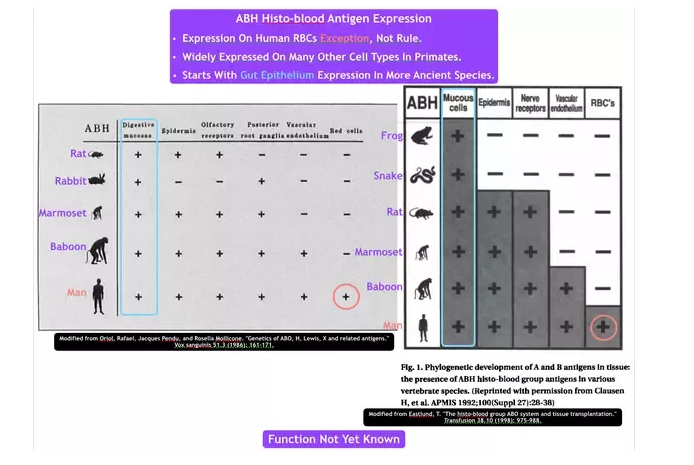
Human Global ABO Distribution (6)
- O is most common globally.
- A is mainly found in North and Central Europe, rarer in Asia.
- B is quite frequent in Central Asia but almost absent among Amerindians, who are almost exclusively O.
- Clearly, the ABO blood group system exemplifies the fact that human blood group antigens are under active, intensive evolutionary selection pressure.
Human ABO Blood Group System & Disease Risk
- Almost on the heels of the 1900 ABO blood group discovery, people started trotting out associations of different blood types with various human traits, ranging from personality to appropriate diets, the so-called blood group dietbeing merely one of the latest such fads. Thus far, being scientifically unsubstantiated is the only clear trait linking such tall claims (7).
- OTOH, for many decades little research was done on differential risk for many diseases with different blood groups but in recent years a steady drip of data supporting such associations has emerged.
- ABO blood groups appear to influence susceptibility to pancreatic and gastric cancers, cardiovascular disease and some infectious/communicable diseases (8; see below from 9) with type O tending to have lower risk.

Cancers
- Several recent epidemiological studies (10, 11, 12, 13, 14) suggest O blood type has lower risk of pancreatic cancer.
- Since 1953 (15), epidemiological studies (16, 17) have found blood type A has increased risk of gastric cancer.
Cardiovascular Disease
- Confirmed by 3 Meta-analysis (18, 19, 20), non-O blood types have increasedrisk of VTE (Venous thrombosis), apparently because circulating Von Willebrand factor is studded with ABH structures in A, B and AB blood types, which in turn increases thrombotic (clotting) risk (see below from 1).
- OTOH, type O tends to have substantially lower levels of circulating von Willebrand factor, which further reduces clotting risk.
- Increased VTE risk is especially well-documented for non-O blood types (21, 22, 23).
- O blood type also has less risk of IS (Stroke), MI (Myocardial infarction) and PAD (Peripheral artery disease) (24).

Infectious/Communicable diseases
- The specific O sub-type, O Lewis b, is associated with
- Helicobacter pylori triggered-peptic ulcer, apparently because certain H. pylori strains can bind O lewis b antigen much more strongly compared to A lewis b (25).
- Type O are also more susceptible to severe infections with Vibrio choleraeand Escherichia coli (8), and to norovirus-associated acute gastroenteritis (26).
- OTOH, type O blood has better outcome and less severe symptoms from malaria, which provides a compelling example of microbial selection pressure on evolution of blood group antigens (27; see below from 28, 29). Protective, i.e., less severe, outcome for type O has been shown both experimentally (30) as well as through GWAS (Genome-wide association study) (31, 32).
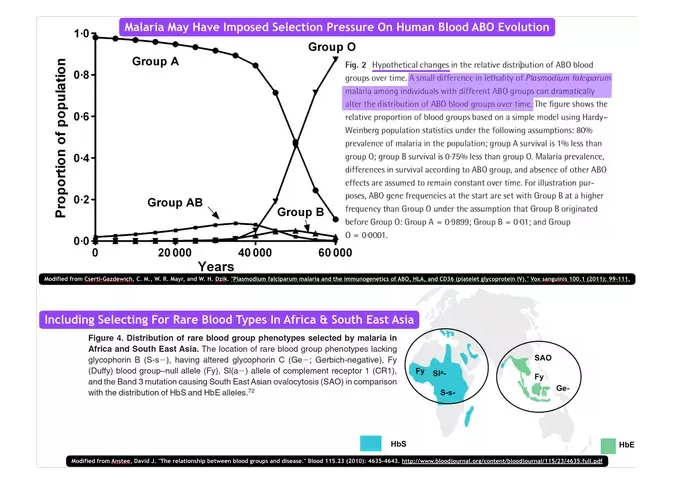
Type O may do better because malaria-infected RBCs express novel proteins such as PfEMP-1 on their surface. In turn, in those with type A or B, such molecules can bind A and B antigens on platelets and blood vessels, setting off an aggregation cascade (see below from 27).
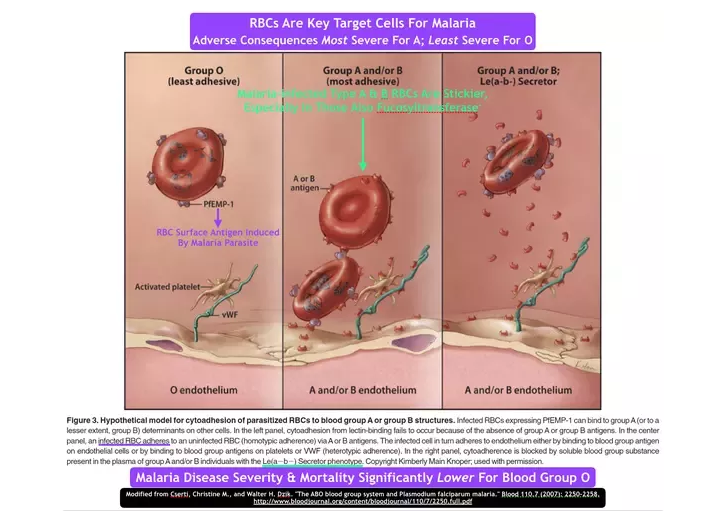
Bibliography
1. Franchini, Massimo, et al. "ABO blood group, hypercoagulability, and cardiovascular and cancer risk." Critical reviews in clinical laboratory sciences 49.4 (2012): 137-149.
3. Quinn, J. G., et al. "Blood: tests used to assess the physiological and immunological properties of blood." Advances in physiology education 40.2 (2016): 165-175.
4. Oriol, Rafael, Jacques Pendu, and Rosella Mollicone. "Genetics of ABO, H, Lewis, X and related antigens." Vox sanguinis 51.3 (1986): 161-171.
5. Eastlund, T. "The histo‐blood group ABO system and tissue transplantation." Transfusion 38.10 (1998): 975-988.
6. Storry, J. R., and Martin L. Olsson. "The ABO blood group system revisited: a review and update." Immunohematology 25.2 (2009): 48-59.
7. Daniels, G. "The myths of blood groups." ISBT Science Series 9.1 (2014): 131-135.
8. Franchini, Massimo, and Carlo Bonfanti. "Evolutionary aspects of ABO blood group in humans." Clinica Chimica Acta 444 (2015): 66-71.
9. Yamamoto, Fumiichiro, et al. "ABO research in the modern era of genomics." Transfusion medicine reviews 26.2 (2012): 103-118.
10. Wolpin, Brian M., et al. "ABO blood group and the risk of pancreatic cancer." Journal of the National Cancer Institute 101.6 (2009): 424-431.
12. Wolpin, Brian M., et al. "Pancreatic cancer risk and ABO blood group alleles: results from the pancreatic cancer cohort consortium." Cancer research 70.3 (2010): 1015-1023.
13. Wolpin, Brian M., et al. "Variant ABO blood group alleles, secretor status, and risk of pancreatic cancer: results from the pancreatic cancer cohort consortium." Cancer Epidemiology Biomarkers & Prevention 19.12 (2010): 3140-3149.
14. Rizzato, Cosmeri, et al. "ABO blood groups and pancreatic cancer risk and survival: results from the PANcreatic Disease ReseArch (PANDoRA) consortium." Oncology reports 29.4 (2013): 1637-1644. ABO blood groups and pancreatic cancer risk and survival: Results from the PANcreatic Disease ReseArch (PANDoRA) consortium
16. Edgren, Gustaf, et al. "Risk of gastric cancer and peptic ulcers in relation to ABO blood type: a cohort study." American journal of epidemiology 172.11 (2010): 1280-1285. Risk of Gastric Cancer and Peptic Ulcers in Relation to ABO Blood Type: A Cohort Study
17. Etemadi, Arash, et al. "Mortality and cancer in relation to ABO blood group phenotypes in the Golestan Cohort Study." BMC medicine 13.1 (2015): 1. Mortality and cancer in relation to ABO blood group phenotypes in the Golestan Cohort Study
18. Dentali, Francesco, et al. "Non-O blood type is the commonest genetic risk factor for VTE: results from a meta-analysis of the literature." Seminars in thrombosis and hemostasis. Vol. 38. No. 05. Thieme Medical Publishers, 2012.
19. Dentali, Francesco, et al. "ABO blood group and vascular disease: an update." Seminars in thrombosis and hemostasis. Vol. 40. No. 01. Thieme Medical Publishers, 2014.
20. Dentali, Francesco, et al. "Relationship between ABO blood group and hemorrhage: a systematic literature review and meta-analysis." Seminars in thrombosis and hemostasis. Vol. 39. No. 01. Thieme Medical Publishers, 2013.
21. Ohira, T., et al. "ABO blood group, other risk factors and incidence of venous thromboembolism: the Longitudinal Investigation of Thromboembolism Etiology (LITE)." Journal of Thrombosis and Haemostasis 5.7 (2007): 1455-1461.
22. Franchini, Massimo, and Mike Makris. "Non-O blood group: an important genetic risk factor for venous thromboembolism." Blood Transfus 11.2 (2013): 164-5.
23. Spiezia, Luca, et al. "ABO blood groups and the risk of venous thrombosis in patients with inherited thrombophilia." Blood Transfus 11.2 (2013): 250-253.
24. Franchini, Massimo, and Carlo Bonfanti. "Evolutionary aspects of ABO blood group in humans." Clinica Chimica Acta 444 (2015): 66-71.
25. Dickey, W., et al. "Secretor status and Helicobacter pylori infection are independent risk factors for gastroduodenal disease." Gut 34.3 (1993): 351-353. Secretor status and Helicobacter pylori infection are independent risk factors for gastroduodenal disease.
27. Cserti, Christine M., and Walter H. Dzik. "The ABO blood group system and Plasmodium falciparum malaria." Blood 110.7 (2007): 2250-2258.
28. Cserti‐Gazdewich, C. M., W. R. Mayr, and W. H. Dzik. "Plasmodium falciparum malaria and the immunogenetics of ABO, HLA, and CD36 (platelet glycoprotein IV)." Vox sanguinis 100.1 (2011): 99-111.
29. Anstee, David J. "The relationship between blood groups and disease." Blood 115.23 (2010): 4635-4643.
30. Rowe, J. Alexandra, et al. "Blood group O protects against severe Plasmodium falciparum malaria through the mechanism of reduced rosetting." Proceedings of the National Academy of Sciences 104.44 (2007): 17471-17476.
31. Fry, Andrew E., et al. "Common variation in the ABO glycosyltransferase is associated with susceptibility to severe Plasmodium falciparum malaria." Human molecular genetics 17.4 (2008): 567-576. Common variation in the ABO glycosyltransferase is associated with susceptibility to severe Plasmodium falciparum malaria
32. Timmann, Christian, et al. "Genome-wide association study indicates two novel resistance loci for severe malaria." Nature 489.7416 (2012): 443-446.
Thanks for the R2A, Nagarajan Srinivas.






















